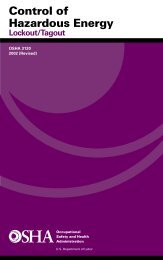Toxic Chemical Release Inventory Reporting Forms and Instructions
Toxic Chemical Release Inventory Reporting Forms and Instructions
Toxic Chemical Release Inventory Reporting Forms and Instructions
Create successful ePaper yourself
Turn your PDF publications into a flip-book with our unique Google optimized e-Paper software.
Facility Eligibility Determination for Submitting an EPCRA Section 313 Report<br />
‘ Otherwise use in routine janitorial or facility<br />
grounds maintenance;<br />
‘ Personal uses by employees or other persons;<br />
‘ Otherwise use of products containing EPCRA<br />
section 313 chemicals for the purpose of<br />
maintaining motor vehicles operated by the facility;<br />
<strong>and</strong><br />
‘ Otherwise use of EPCRA section 313 chemicals<br />
contained in intake water (used for processing or<br />
non-contact cooling) or in intake air (used either as<br />
compressed air or for combustion).<br />
The exemption of an EPCRA section 313 chemical otherwise<br />
used 1) as a structural component of the facility; or 2) in<br />
routine janitorial or facility grounds maintenance; or 3) for<br />
personal use by an employee cannot be taken for activities<br />
involving process-related equipment.<br />
Articles Exemption. EPCRA section 313 chemicals<br />
contained in articles that are processed or otherwise used at<br />
a covered facility are exempt from threshold determinations<br />
<strong>and</strong> release <strong>and</strong> other waste management calculations. The<br />
exemption applies when the facility receives the article from<br />
another facility or when the facility produces the article itself.<br />
The exemption applies only to the quantity of EPCRA<br />
section 313 chemical present in the article. If the EPCRA<br />
section 313 chemical is manufactured (including imported),<br />
processed, or otherwise used at the covered facility other<br />
than as part of the article, in excess of an applicable threshold<br />
quantity, the facility is required to report (40 CFR Section<br />
372.38(b)). For an EPCRA section 313 chemical in an item<br />
to be exempt as part of the article, the item must meet all the<br />
following criteria in the EPCRA section 313 article<br />
definition; that is, it must be a manufactured item (1) which<br />
is formed to a specific shape or design during manufacture,<br />
(2) which has end use functions dependent in whole or in<br />
part upon its shape or design during end use, <strong>and</strong> (3) which<br />
does not release a toxic chemical under normal conditions of<br />
processing or otherwise use of the item at the facility.<br />
The articles exemption applies to the normal processing or<br />
otherwise use of articles. This exemption does not apply to<br />
the manufacture of the article. EPCRA section 313<br />
chemicals incorporated into articles produced at a facility<br />
must be factored into threshold determinations <strong>and</strong> release<br />
<strong>and</strong> other waste management calculations.<br />
If, in the course of processing or otherwise use, an item<br />
retains its initial thickness or diameter, in whole or in part, it<br />
meets the first part (i.e., it must be a manufactured item<br />
which is formed to a specific shape or design during<br />
manufacture) of the article definition. If the item's basic<br />
dimensional characteristics are totally altered during<br />
processing or otherwise use, the item does not meet the first<br />
part of the definition. An example of items that do not meet<br />
the definition would be items which are cold extruded, such<br />
as lead ingots, which are formed into wire or rods. On the<br />
other h<strong>and</strong>, cutting a manufactured item into pieces which are<br />
recognizable as the article would not change the original<br />
dimensions as long as the diameter or the thickness of the<br />
item remained the same; the articles exemption would<br />
continue to apply. Metal wire may be bent <strong>and</strong> sheet metal<br />
may be cut, punched, stamped, or pressed without losing<br />
their article status as long as the diameter of the wire or<br />
tubing or the thickness of the sheet is not totally changed.<br />
An important aspect of the articles exemption is what<br />
constitutes a release of an EPCRA section 313 chemical.<br />
Any processing or otherwise use of like articles that results<br />
in a release to the environment (of more than 0.5 pounds)<br />
negates the article status <strong>and</strong> precludes eligibility for the<br />
exemption. Cutting, grinding, melting, or other processing<br />
of manufactured items could result in a release of an EPCRA<br />
section 313 chemical during normal conditions of processing<br />
or otherwise use <strong>and</strong> therefore negate the exemption as<br />
articles.<br />
If the processing or otherwise use of all like items results in<br />
a total release of 0.5 pound or less of an EPCRA section 313<br />
chemical in a reporting year to any environmental medium,<br />
EPA will allow this release to be rounded to zero, <strong>and</strong> the<br />
manufactured items retain their article status. The 0.5 pound<br />
threshold does not apply to each individual article, but<br />
applies to the sum of all releases from processing or<br />
otherwise use of all like articles. If all the releases of like<br />
articles over a reporting year are completely captured <strong>and</strong><br />
recycled/reused on-site or off-site, those items retain their<br />
article status. Any amount that is released <strong>and</strong> is not<br />
recycled/reused will count toward the 0.5 pound per year<br />
cut-off value.<br />
16 <strong>Toxic</strong>s <strong>Release</strong> <strong>Inventory</strong> <strong>Reporting</strong> <strong>Forms</strong> <strong>and</strong> <strong>Instructions</strong>
















